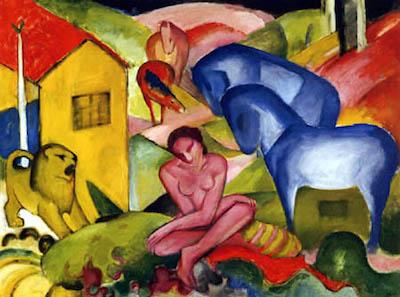Illies, Florian. 1913: The Year Before the Storm. Melville House, Brooklyn/London, (268pp. $25.95)
Overcoming the curse of Romanticism in the effort to become modern can be dangerous to one’s health. Just ask Franz Kafka, whose psychosexual and intestinal battles are the stuff of legend; or, ask Igor Stravinsky, who in May 1913, was in rehearsals for the infamous, or famous, premier of Rite of Spring, a ballet choreographed to Stravinsky’s revolutionary music by Diaghilev, to be danced by the enigmatic Russian Najinsky, a premier which caused a theater riot. At the post-rehearsal party, there appeared Maurice Ravel, Andre Gide, and even the indefatigable Harry Graf Kessler, who seemed to be everywhere, chronicling everything in his fabled diaries. Of course, everyone in Germanic culture seemed to be keeping a diary. What with an epidemic of musical beds, coruscated or fractured friendships, and petty artistic jealousies and bombastic rivalries, how could one keep track of every grudge without writing them down?
Florian Illies’s new book is most emphatically not an historical overview, nor is it really history at all. Instead, it is a magically creative and entirely offbeat snapshot of the arbiters of European culture at a specific turning point in literature, music and painting. Each section captures a month during 1913, using aphorisms, diary entries, narrative, speculation and historical fact, stitched together in imaginative, sometimes riotously funny ways. Funny too that such a critical juncture for high art should occur slightly ahead of one of the world’s greatest catastrophes, World War I.
Illies, a German journalist, is the author of four previous books that were bestsellers in Europe, and cofounder of the art magazine Monopol. His book 1913 is the first to be translated into English; and one must say, flawlessly so by Shaun Whiteside and Jamie Lee Searle, preserving as it does all of the author’s laconic wit. Composed mostly of short paragraphs (with an occasional longer foray into exposition), and a few single sentences that retort like a rifle crack on the page, 1913 displays European modernism like a flashing covey of arrows arcing overhead in some Greek land battle where phalanxes toil. For example, in April Franz Kafka declares himself to be ill, writing to his friend Max Brod that he feels “cut up like a joint of meat”, hardly sleeping, and writing only letters to his phantom fiance Felice in Berlin, a slender thread of unreality that represents Kafka’s ambivalence about sexual matters. In order to cure himself (self-cure was popular in Prague), he turns to weeding at the public gardens, choosing vegetables over flowers—what else for the tormented obsessive compulsive?
An astonishing array of characters parade by in this book—Stalin as a revolutionary, Hitler as a watercolorist, crazy poets, Rilke living off his women, Oscar Kokoshka bedding the widow of Mahler, everybody bedding everybody, Gottfried Benn confused by modern poetry, and many others—Arthur Schnitzler, Thomas and Heinrich Mann; there are woman galore—Coco Chanel in Paris, Else Lasker Schuler, Kathe Kollwitz in Berlin, Gertrude Stein, and the many mistresses and hangers-on; one is afraid to leave out Freud, Kirchner, Wittgenstein, Einstein, Schoenberg, Matisse, Picasso—well, you get the idea. Mainly, 1913 is great fun, a book written with subtle wit, a clear style and a sly, deprecating form, though what eventuates is a very serious attempt to understand modern art at its founding moment from a profoundly personal standpoint. Concepts like neurasthenia, the unconscious, artistic license, and the art business itself play major roles as modernism shucks off its romantic mantle and turns serious.
Illies has a deft hand—he writes: “On March 9 the profoundly depressive 32-year old Virginia Woolf sends the manuscript of her first novel to her publishers. She has worked on it for six years. It also happens to be the day when her future lover Vita Sackville-West comes of age, having reached twenty-one. But for now, Virginia Woolf is trapped in some very old spider’s webs.” On the same day we’re told that the painter Franz Marc decides to illustrate the Bible with some artist friends, writing to Kandinsky, Klee, Heckel and Kokoshka. They, for diverse reasons, decline. Marc gets as far as Creation and quits.
For the reader though, this grand, brilliant jigsaw puzzle of a book is impossible to quit.


